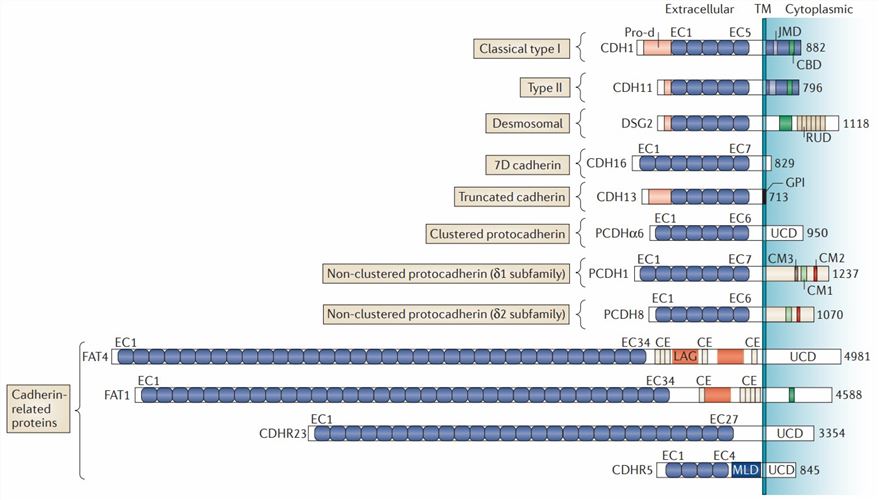What is CDH16 Protein
CDH16 protein is a member of the cadherin superfamily. This glycoprotein, also known as cadherin-16, plays a key role in calcium-dependent cell-cell adhesion, particularly in the renal epithelium.
CDH16 is an important member of the cadherin superfamily and is essential for maintaining cell integrity through calcium-dependent adhesion. CDH16 is mainly expressed in the kidney, where it contributes to the formation of adherens junctions and stabilizes the renal tubular epithelium. This glycoprotein is key to cell interactions, facilitating the binding of adjacent cells and ensuring the structural robustness of renal tissues.
 Figure 1. Schematic overview of representative members of the cadherin superfamily with involvement in cancer (van Roy, F. 2014)
Figure 1. Schematic overview of representative members of the cadherin superfamily with involvement in cancer (van Roy, F. 2014)The Function of CDH16 Protein
At its core, CDH16 coordinates calcium reabsorption in the kidneys, an important function in maintaining calcium balance in the body. By forming adherens junctions, CDH16 stabilizes renal tubules and prevents calcium loss through urine. This relationship between cell adhesion and calcium regulation emphasizes the integral role of this protein in renal physiology.
CDH16-Related Diseases
Dysregulation or mutations in the CDH16 gene are associated with several kidney disorders. One such disorder is hypercalciuria, which is characterized by elevated levels of calcium in the urine. Dysfunction of CDH16 results in impaired calcium reabsorption, setting the stage for kidney stone formation. Additionally, CDH16 is involved in renal cell carcinoma (RCC), making it a key player in the pathogenesis of some cancers, linking aberrant protein function to tumorigenesis.
CDH16 Related Signaling Pathways
The complexity of CDH16's function extends to its involvement in signaling pathways, particularly the Wnt signaling pathway. Studies have demonstrated dynamic interactions between CDH16 and Wnt pathway components, affecting cellular processes such as proliferation and differentiation. This crosstalk reveals the molecular complexity that underpins normal kidney development and provides insights into how dysregulation contributes to CDH16-related diseases, providing potential avenues for targeted therapeutic intervention.
Applications of CDH16 in Biomedical Research
In addition to its role in disease pathology, CDH16 is also a promising player in biomedical applications, opening avenues for innovative approaches to diagnosis and therapeutics.
- Therapeutic Target in Renal Disorders
Therapeutic intervention targeting CDH16 holds promise for the treatment of renal diseases, particularly those associated with abnormalities in calcium metabolism. Modulating the expression or activity of CDH16 may provide a new way to restore normal calcium reabsorption, address conditions such as hypercalciuria, and mitigate kidney stone formation.
- Cancer Therapeutics
The link between CDH16 and renal cell carcinoma makes it a potential target for cancer treatment. Understanding the molecular complexity of CDH16 dysregulation in cancer cells could pave the way for targeted therapies that disrupt pathways associated with tumor growth.
- Diagnostic Biomarkers
The unique expression pattern of CDH16 makes it an interesting diagnostic biomarker. Detecting changes in CDH16 levels or function could serve as an early indicator of renal dysfunction or the presence of certain cancers, allowing for timely, targeted diagnostic approaches.
- Biomedical Imaging
Exploiting CDH16's role in cell adhesion and tissue integrity makes it an attractive target for biomedical imaging. Approaches that specifically target CDH16 can provide insights into tissue architecture and visualize cellular changes associated with disease progression.
In the field of molecular biology, CDH16 is not only a guardian of cellular adhesion and calcium regulation but also a beacon of hope in therapeutics and diagnostics. From uncovering the molecular complexity of renal disorders to exploring its role in cancer therapeutics and diagnostic innovation, CDH16 is at the forefront of biomedical research and offers a glimpse into the future of precision medicine.
Recommended Products for CDH16 Protein
| Cat.# | Species | Product name | Source (Host) | Tag |
|---|---|---|---|---|
| CDH16-2090H | Human | Recombinant Human CDH16 protein, His & T7-tagged | E.coli | His/T7 |
| CDH16-0976H | Human | Recombinant Human CDH16 Protein, GST-Tagged | Wheat Germ | GST |
| CDH16-3860H | Human | Active Recombinant Human CDH16 protein, His-tagged | HEK293 | His |
| CDH16-3424H | Human | Recombinant Human CDH16 protein, His-tagged | E.coli | His |
| CDH16-3151H | Human | Recombinant Human CDH16 Protein, MYC/DDK-tagged | HEK293 | Myc/DDK |
| CDH16-3138HF | Human | Recombinant Full Length Human CDH16 Protein, GST-tagged | In Vitro Cell Free System | GST |
| CDH16-1231H | Human | Recombinant Human CDH16 Protein (Pro18-Ala786), C-His tagged | Mammalian cells | C-His |
| CDH16-1232H | Human | Recombinant Human CDH16 Protein (Phe37-Asn287), N-His tagged | E.coli | N-His |
| Cdh16-2091M | Mouse | Recombinant Mouse Cdh16 protein, His & T7-tagged | E.coli | His/T7 |
| Cdh16-860M | Mouse | Recombinant Mouse Cdh16 Protein, MYC/DDK-tagged | HEK293T | MYC/DDK |
Reference
- van Roy, F. Beyond E-cadherin: roles of other cadherin superfamily members in cancer. Nat Rev Cancer. 2014, 14: 121-134.

